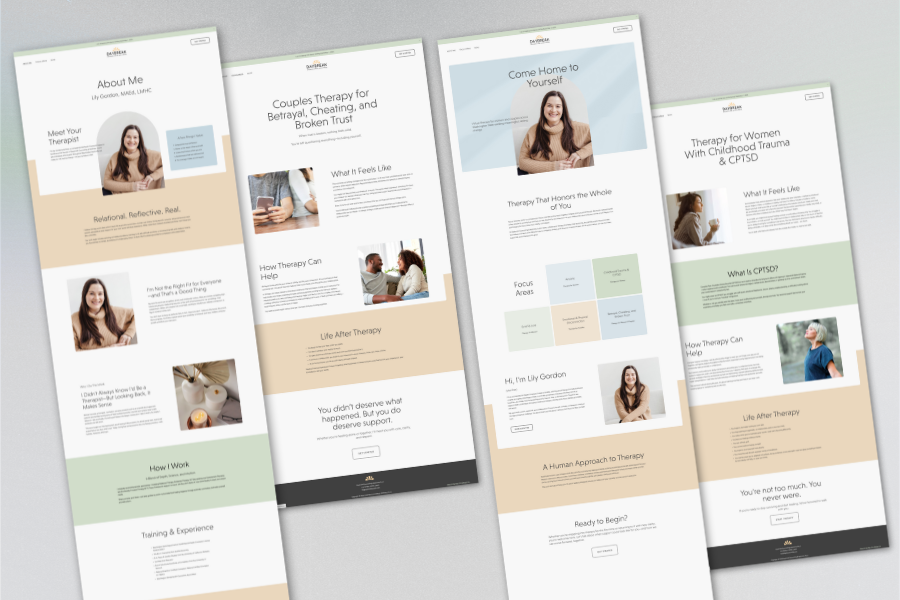The Therapy Niches Poised to Surge in 2026
This article outlines eight therapy niches that are likely to rise in popularity in 2026. It explains why each niche is growing, the types of clients seeking support, and what therapists should consider when updating their website strategy to match emerging demand. Topics include ADHD, complex trauma, men’s relational shifts, burnout, loneliness, digital overload, women’s midlife mental health, and chronic illness.
The Therapy Niches Poised to Surge in 2026
Therapy has always followed culture. When life changes, people feel it in their nervous systems first, then in their relationships, then in their habits, and eventually in a therapist’s inbox.
As we move into 2026, certain themes are showing up everywhere. More adults are struggling with attention and overwhelm. More relationships are straining under changing expectations. More people feel disconnected, overstimulated, or burned out. And trauma language has moved from clinical settings into everyday conversations.
The point of this article is not to guess what will be trendy. It is to name the areas where demand is already building and where therapists will likely see more clients looking for very specific types of support. Clearer niches help clients find the right fit. They also help therapists build practices that feel aligned and sustainable.
Below are the eight niches most likely to grow in 2026 and why they matter.
Why Certain Niches Rise in the First Place
Niches expand when cultural pressure, emotional need, and accessible language come together. Right now, several forces are shaping the landscape.
People talk more openly about mental health. They recognize symptoms earlier. Diagnostic awareness has increased, especially for ADHD and trauma. At the same time, many adults are dealing with chronic stress, job insecurity, inconsistent work boundaries, or social isolation.
Relationships are changing too. Traditional roles are shifting. Many men and women are renegotiating what partnership even looks like. Social media and technology are creating constant mental noise, while also making real connection harder.
Trauma concepts are now mainstream. Nervous system language, attachment wounds, emotional neglect, and chronic stress responses are familiar ideas. This makes space for deeper work and more specialized support.
When these pressures accumulate, people seek therapy for problems they can finally name. That is why these niches are rising.
The Eight Niches Most Likely to Grow in 2026
Below, each niche is presented the same way:
Why it is rising.
The clients you will see.
What this means for therapists.
1. ADHD and Executive Functioning Support
Why it’s rising:
Adult ADHD diagnoses continue to climb and many people who were never evaluated as kids are recognizing the symptoms in themselves. Executive functioning has become everyday vocabulary. People want help with focus, follow through, emotional regulation, and consistency.
The clients you will see:
Late diagnosed adults. High achievers who feel scattered. Women who were missed in childhood. Adults who feel overloaded, disorganized, or constantly behind.
What this means for therapists:
Focus on clear, relatable language. Offer practical tools. Keep the tone validating and skills forward. This niche is in high demand and has strong SEO potential.
2. Complex Trauma and CPTSD
Why it’s rising:
Clients understand trauma in a broader way. Emotional neglect and attachment wounds are being named openly. Somatic and integrative trauma treatments are becoming more visible. Social instability and chronic stress magnify trauma symptoms.
The clients you will see:
High functioning adults who feel stuck, numb, overwhelmed, or ashamed. People with patterns linked to early trauma. Clients seeking EMDR, somatic work, parts work, or trauma focused intensives.
What this means for therapists:
Create trauma pages that are specific and validating. Use accessible language rather than clinical jargon. Consider expanding into sub niches within trauma or adding specialized offerings.
3. Men’s Relational and Identity Shifts
Why it’s rising:
Men are struggling with loneliness at higher rates. Relationship expectations are changing, especially as more women insist on emotional presence and shared responsibility. Economic pressure and shifting gender roles add to identity confusion.
The clients you will see:
Men who feel disconnected or unsure how to communicate. Men navigating partnership stress, breakups, or identity transitions. Dads who feel overwhelmed. High achieving men who feel lost or stuck.
What this means for therapists:
Keep messaging straightforward. Use language that feels accessible. Focus on communication skills, emotional awareness, conflict repair, and purpose. This niche is underserved and will continue to grow.
4. Burnout and Work Stress Recovery
Why it’s rising:
Work and life boundaries have blurred. Remote and hybrid work increase isolation. Economic stress pushes people into overdoing. Many adults are questioning whether their current path is sustainable. Burnout is no longer rare. It is common.
The clients you will see:
High performers who cannot slow down. Adults who feel drained or resentful. People who want to redefine their relationship to work. Clients carrying guilt about setting boundaries.
What this means for therapists:
Emphasize clarity, relief, and sustainable habits. Help clients slow down, reorganize, and align their choices with their values. This is also a strong niche for group work or intensives.
5. Loneliness, Friendship Skills, and Social Connection
Why it’s rising:
Many adults feel disconnected. Making friends feels harder than it used to. Remote work, relocations, dating burnout, and social shifts have created a real need for support with building meaningful relationships.
The clients you will see:
Adults who want deeper friendships. People who feel socially rusty after life transitions. Clients who know they need connection but do not know where to start.
What this means for therapists:
Highlight practical social skills, confidence building, and authentic communication. This niche is especially powerful for young adults and people in major life transitions.
6. Digital Overload and Tech Related Mental Fatigue
Why it’s rising:
People feel overstimulated and overstretched. Social media, news cycles, and constant notifications compete for attention. Many clients describe feeling drained, distracted, or addicted to their screens.
The clients you will see:
Adults who cannot stop checking their phone. Teens overwhelmed by comparison and pressure. Parents unsure how to manage screen habits at home. People who want their attention span back.
What this means for therapists:
Position your work as a path back to presence and focus. Emphasize attention skills, emotional regulation, and healthier screen habits. Skills based approaches work well here.
7. Women’s Midlife Mental Health
Why it’s rising:
Perimenopause and menopause are finally being discussed more openly. Women in midlife often juggle work, caregiving, identity shifts, and relationship changes. Mood symptoms and emotional fatigue increase during this phase.
The clients you will see:
Women in their forties and fifties who feel irritable, anxious, weepy, or overwhelmed. Women who are rethinking their lives, careers, or partnerships. Clients who want support and psychoeducation.
What this means for therapists:
Use validating language that normalizes hormonal and emotional changes. Focus on identity, relationship patterns, mood support, and self trust. There is huge demand for therapists who understand this life stage.
8. Chronic Illness, Long COVID, and Medical Trauma
Why it’s rising:
Chronic illness affects more people than most realize. Long COVID continues to shape daily functioning. Many clients feel dismissed in medical settings and want a therapist who understands that experience.
The clients you will see:
Adults grieving lost abilities or routines. People frustrated by limited answers. Clients who feel alone in managing symptoms or navigating the medical system.
What this means for therapists:
Lead with validation. Offer identity work, pacing strategies, and emotional support for the push and crash cycles that often come with chronic illness. Clients want a therapist who believes them and helps them rebuild a workable life.
How These Trends Shape Website Strategy for Therapists
Clear niches make stronger websites. When a therapist speaks directly to the problems a client is searching for, conversion increases. Clients want to feel understood. They also want clarity. They want to know what you do, who you help, and how you help them.
A few things matter more in 2026 than in previous years.
Make sure your homepage is simple and easy to scan.
Use direct headings that tell visitors what you offer.
Create service pages that focus on specific problems rather than general therapy language.
Use location based keywords if you work in person or in state specific telehealth.
Organize your navigation so clients can find what they need within seconds.
Write blog posts related to your niche to improve SEO and support people who are still exploring their options.
When your website is clear, the right clients recognize themselves instantly.
How to Know If One of These Niches Is Right for You
You do not need to overhaul your entire practice to choose a niche. You can start with one service page, one type of client, or one specific problem you feel confident treating.
Ask yourself a few questions.
Do you enjoy this work.
Do you feel effective with these clients.
Does this niche exist in your community or online audience.
Does it align with your strengths or your natural way of working.
Does it help you build a sustainable practice that does not drain you.
Choosing a niche is not about limiting yourself. It is about making your practice easier to run and easier for clients to understand.
Pin it!
Some of My Favorite Private Practice Tools
Resources and Referral Links









































